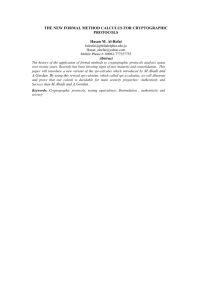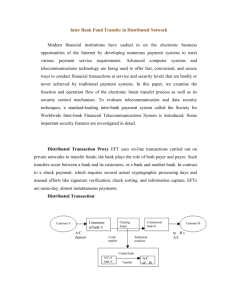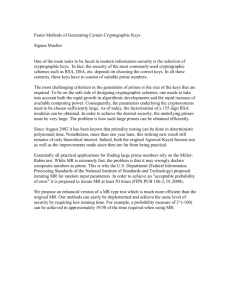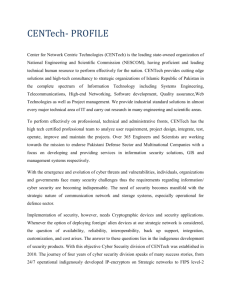protocols cryptographic
advertisement
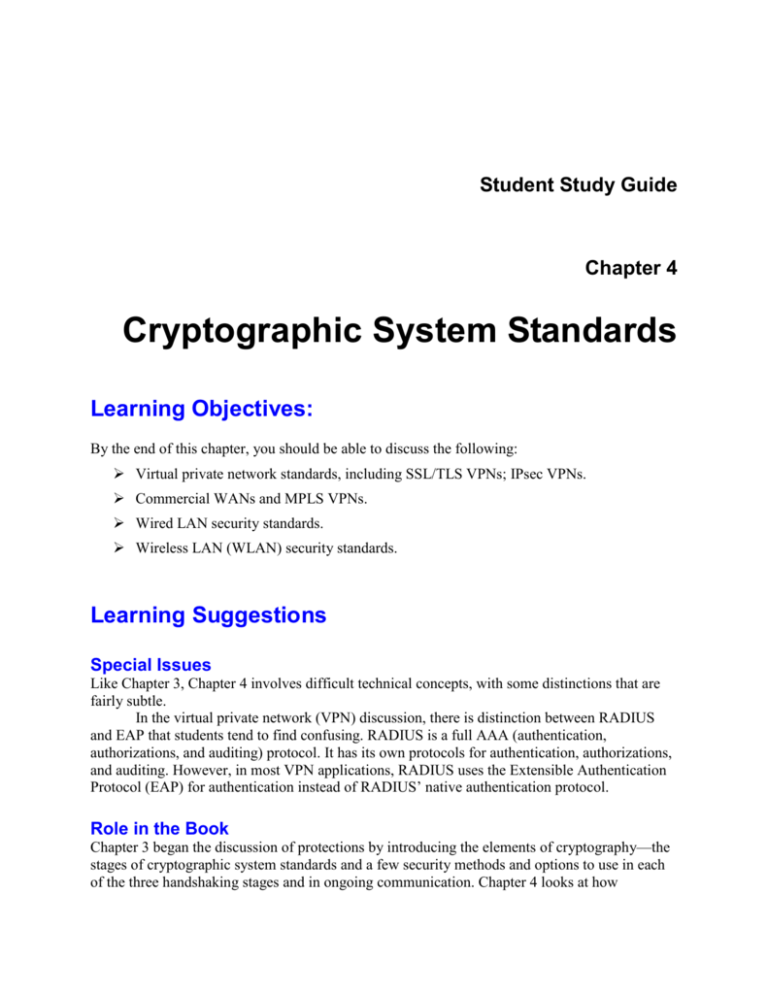
Student Study Guide Chapter 4 Cryptographic System Standards Learning Objectives: By the end of this chapter, you should be able to discuss the following: Virtual private network standards, including SSL/TLS VPNs; IPsec VPNs. Commercial WANs and MPLS VPNs. Wired LAN security standards. Wireless LAN (WLAN) security standards. Learning Suggestions Special Issues Like Chapter 3, Chapter 4 involves difficult technical concepts, with some distinctions that are fairly subtle. In the virtual private network (VPN) discussion, there is distinction between RADIUS and EAP that students tend to find confusing. RADIUS is a full AAA (authentication, authorizations, and auditing) protocol. It has its own protocols for authentication, authorizations, and auditing. However, in most VPN applications, RADIUS uses the Extensible Authentication Protocol (EAP) for authentication instead of RADIUS’ native authentication protocol. Role in the Book Chapter 3 began the discussion of protections by introducing the elements of cryptography—the stages of cryptographic system standards and a few security methods and options to use in each of the three handshaking stages and in ongoing communication. Chapter 4 looks at how Chapter 4: Cryptographic Systems Corporate Computer and Network Security, 2nd Edition Raymond R. Panko Copyright Prentice-Hall, 2010 protections are applied in several popular cryptographic system standards, such as SSL/TLS and IPsec. Chapter 4 completes the discussion of cryptographic security, but we will see cryptographic security and cryptographic security systems throughout the book. Flow of Material When organizations must transmit across untrusted networks, such as wireless LANs and the Internet. They usually apply cryptographic protections. The resultant protection is called a virtual private network (VPN). VPNs follow specific cryptographic security standards. The chapter looks in some detail at the two most popular cryptographic VPN standards: SSL/TLS and IPsec. SSL/TLS only requires the client to have a browser and avoids all extra client setup. However, SSL/TLS has some important limitations in how it can be used. The more general IPsec cryptographic system standard is an extremely powerful and universal protection tool for VPNs and even allows central corporate control. However, IPsec is more complex and expensive to administer, especially in transport mode but even in tunnel mode. The chapter then briefly discusses security in WAN services offered by carriers, including Layer 3 MPLS services. These services offer no cryptographic security at all, although the offer some security through obscurity by restricting access and hiding routing information. MPLS services may be called VPNs, but they are routed VPNs instead of cryptographic VPNs. Wired LANs use Ethernet almost exclusively today. To prevent someone from simply walking into a firm and plugging into any available wall jack, companies can use 802.1X access control. Before someone can use the network, he or she has to do authentication. In this authentication, the workgroup switch acts as an authenticator. It primarily passes messages between the supplicant client and a back-end authentication server that follows the RADIUS protocol. Under 802.1X, the native RADIUS authentication protocol is replaced by the Extensible Authentication Protocol (EAP). Other native RADIUS AAA protocols, including authorization and auditing protocols, are not replaced. Most firms are not too concerned with their wired LAN security, but nearly all are concerned by wireless LAN security. To protect communication between the wireless access point and wireless clients, the 802.11 Working Group first produced the WEP standard, but this had very poor security. Later, the 802.11 Working Group produced the 802.11i standard, but before that did so, the Wi-Fi Alliance produced a simplified version of 802.11i, which they called WPA. Both WPA and 802.11i are now used widely in organizations. There are two ways to implement 802.11i and WPA. In 802.1X mode, the wireless access points are the authenticators and a central authentication server is used. The version of 802.1X developed for WLANs uses an enhanced EAP protocol that first sets up an SSL/TLS connection between the wireless access point and the wireless client. Companies with a single access point do not require a central authentication server because both 802.11i and WPA offer a simpler non-802.1X mode of operation, preshared key mode. Although 802.11i and WPA offer good security, they cannot defeat evil twin man-in-the-middle attacks. Defeating evil twin attacks requires the use of a VPN Page 4-2 Chapter 4: Cryptographic Systems Corporate Computer and Network Security, 2nd Edition Raymond R. Panko Copyright Prentice-Hall, 2010 between the wireless client and end server or network. Another threat that 802.11i and WPA cannot defeat is the rogue access point, which is an unauthorized access point set up without security. To combat evil twin attacks, rogue access points, and other attacks, many firms now use wireless intrusion detection systems that collect data from wireless access points to look for indications of attacks. Learning Aids in the Book The book has a number of features that can help you learn the material. Bite-Sized Sections. The chapters are divided into small sections with headings. Teachers tend to hate it, but students usually like it. It allows them to learn individual chunks of information and orients them to where they are in longer discussions. Test Your Understanding Questions. After each section or subsection, there are Test Your Understanding questions. As the name suggests, these questions are designed to let you know if you understand the material you have just read. The multiple choice questions and true/false questions are all taken from the Test Your Understanding and End-ofChapter questions. Definitions. Important or difficult ideas are often set off in smaller type with a rule line before and after. Be absolutely sure you absolutely know these concepts, and study them before exams. Figures. The figures cover nearly all important concepts in the book and show their interrelationships. If you already know the material fairly well, the figures are great ways to see how the topics fit together. If you can explain the figures, you probably have a good working knowledge of the chapter. End of Chapter Questions. The questions at the end of the chapter are designed to have you integrate or really understand what you have learned. If you do them right, you will get real “ah ha” moments. Studying the Material Students tend to have several problems with the material in this and other chapters. There is a lot of material to master. Mastering it will take a lot of time and effort. In addition, you can’t cherry pick to look for “the important concepts.” The most successful students read a section carefully, then stop to do the Test Your Understanding questions after the section. If they have any doubt, they go back over the material. This way, they have mastered the concepts, which later material in the chapter will probably require. Some of the material is abstract. The problem with abstract material is that you don’t have a mental framework for understanding it. The solution, painful as it is, is to go over it several times, if possible hours or days apart. Things gradually become clearer as you brain develops a framework. Keep at it until you really understand individual concepts. Hazy notions aren’t enough. Try to come up with examples. Page 4-3 Chapter 4: Cryptographic Systems Corporate Computer and Network Security, 2nd Edition Raymond R. Panko Copyright Prentice-Hall, 2010 Some material, such as the creation of digital signatures in Chapter 3, involves a series of steps. Many students have a difficult time with such material. Their eyes glaze over after one or two steps. The key again is to go over it multiple times. Learn the details of each step. Then focus on the overview of how the pieces fit together into a process. Repeat until you have a solid understanding and can explain it to someone else. Thought questions require you to understand, integrate, and apply the concepts that you learned in the chapter. Even if you have a solid understanding, thought questions will require you to put things together. Don’t give up if it doesn’t come to you right away. Write down what you know from the question, what you need to find, and what you learned in the chapter. If this seems complicated, it is. It is also what you will be doing for the rest of your life. In troubleshooting questions, don’t try to find the answer immediately. Come up with a list of possible causes. Then try to eliminate as many of them as you can by logic. Then figure out how to test the rest. Successful troubleshooters make sure they understand the situation and list many alternatives before they begin to explore one approach to solving the problem. Inexperienced troubleshooters go down one dead-end road after another and take far longer. A lot of material consists of comparing and contrasting things that are similar but also different. Learning to master such material is critical in working life. IT people in all job specialties have to choose between several ways to implement a solution, and they cannot even understand problems without understanding similarities and differences between possible attacks. The best way to understand similar but dissimilar concepts is to create boxes comparing and contrasting them. The book has done some of this for you, but don’t try to memorize things. Try to really understand them. The following is a way to think about viruses and worms, for example. Viruses Worms Directly Propagating Worms No Attach themselves to other programs Can spread via e-mail Cam propagate directly Yes No Yes No NA Yes Can spread very rapidly Can be stopped by antivirus programs (at least usually) Can only be stopped by firewalls and vulnerability patching No Yes Yes No, in general No Yes No No Yes Yes NA Page 4-4


